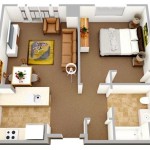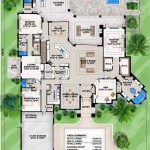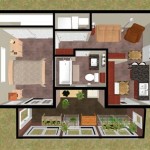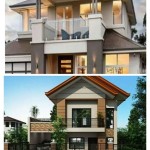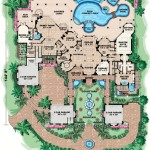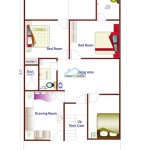Four Bedroom Apartment Floor Plans: Considerations and Designs
Four-bedroom apartment floor plans represent a significant niche in the real estate market, catering to families, groups of individuals sharing accommodation, or those requiring ample space for work and leisure. The design considerations for such apartments extend beyond simply maximizing the number of bedrooms; functionality, flow, privacy, and storage are crucial aspects to consider. This article explores various facets of four-bedroom apartment floor plans, delving into design trends, functional elements, and factors influencing their overall appeal.
The demand for four-bedroom apartments is often driven by the need for both communal living space and private retreats. Families with multiple children, or individuals desiring guest rooms, home offices, or hobby spaces, find these layouts appealing. The design must strike a balance between shared areas, such as the living room and kitchen, and the individual bedrooms. The allocation of space directly impacts the livability and perceived value of the apartment.
Key Point 1: Variations in Four-Bedroom Apartment Layouts
Four-bedroom apartment floor plans come in a variety of layouts, each offering distinct advantages and disadvantages. These layouts are often categorized by the positioning of the bedrooms relative to the common areas and to each other. Understanding these basic configurations is essential for determining which plan best suits specific needs and preferences.
One common layout is the "linear" or "railroad" style. In this configuration, bedrooms are often situated in a consecutive line along one side of the apartment, with the living room and kitchen located on the opposite side. This design can be efficient in terms of maximizing space utilization, but it can also lead to limited natural light for the inner bedrooms and potential noise transmission between adjacent rooms. Furthermore, privacy for occupants in the bedrooms furthest from the entrance might be compromised.
Another layout is the "cluster" or "zoned" design. This involves grouping the bedrooms together in one area of the apartment, effectively creating a private wing. This configuration often provides enhanced privacy and reduced noise levels for the occupants of the bedrooms. The living room, kitchen, and dining area are then located in a separate zone, facilitating a clear distinction between living and sleeping spaces. However, this layout might require a larger overall square footage and potentially necessitate longer hallways, which could feel less efficient.
A third option is the "corner" layout. In this model, the bedrooms are strategically placed in different corners of the apartment. This design is frequently found in buildings with a rectangular or square footprint, leveraging the corners of the building to maximize natural light and views for each bedroom. Corner layouts often provide a good balance of privacy and access to natural light, but the central common areas may feel somewhat isolated or fragmented depending on the specific design.
Duplex or multi-story four-bedroom apartments present an additional variation. These layouts distribute the living spaces and bedrooms across multiple floors, often providing a sense of separation and privacy that is not achievable in a single-story apartment. Duplex configurations can be particularly appealing to families seeking clearly defined living and sleeping zones.
Key Point 2: Essential Design Elements and Considerations
Beyond the fundamental layout, several design elements significantly impact the functionality and appeal of a four-bedroom apartment floor plan. These elements include the size and configuration of individual bedrooms, the placement and design of bathrooms, the integration of storage solutions, and the flow between common areas.
Bedroom size is a critical factor. While the definition of a "bedroom" often requires a minimum square footage and the presence of a window and closet, the actual usable space within each bedroom should be adequate for a bed, a desk or dresser, and comfortable movement. The master bedroom typically features a larger square footage and may include an en-suite bathroom and walk-in closet. The remaining bedrooms often have smaller footprints and may share a bathroom.
The number and placement of bathrooms are essential for a four-bedroom apartment. Ideally, there should be at least two full bathrooms to accommodate the needs of multiple occupants. An en-suite bathroom attached to the master bedroom is a desirable feature, offering enhanced privacy and convenience. The location of the second bathroom should be easily accessible from the remaining bedrooms and common areas. The design of the bathrooms should prioritize functionality and ease of cleaning, incorporating durable materials and efficient fixtures.
Storage is another crucial consideration. Four-bedroom apartments typically require ample storage space to accommodate the belongings of multiple occupants. Closets should be adequately sized and strategically located in each bedroom. Linen closets, coat closets, and utility closets are also essential for organizing household items. Furthermore, built-in storage solutions, such as shelving units or cabinets, can maximize space utilization and enhance the overall organization of the apartment.
The flow between common areas is essential for creating a comfortable and functional living space. The living room, kitchen, and dining area should be seamlessly connected, allowing for easy interaction and movement. An open-concept layout is often preferred, as it promotes a sense of spaciousness and facilitates socializing. However, it is also important to define distinct zones within the common areas to maintain a sense of order and functionality. For example, a kitchen island can serve as a natural divider between the kitchen and dining area.
Natural light and ventilation are fundamental considerations for all rooms, including the bedrooms and common areas. Windows should be strategically placed to maximize natural light penetration and provide adequate ventilation. Large windows or sliding glass doors can create a connection to the outdoors and enhance the overall ambiance of the apartment. The orientation of the apartment within the building can also impact the amount of natural light received, and this should be considered during the design process.
Key Point 3: Adaptability and Future Considerations
The design of a four-bedroom apartment floor plan should also consider adaptability and future needs. Tastes and requirements can change over time, and the apartment should be designed in a way that allows for flexibility and modification. This can involve choosing neutral color palettes, incorporating durable materials, and designing spaces that can be easily repurposed.
One key aspect of adaptability is the ability to repurpose bedrooms. A bedroom that is initially used for children can later be converted into a home office, a guest room, or a hobby space. This requires careful consideration of the bedroom's size, layout, and features. For example, a bedroom with a large window and ample closet space would be suitable for a variety of uses.
The use of flexible furniture and storage solutions can also enhance adaptability. Modular furniture can be easily reconfigured to suit different needs and preferences. Storage solutions that can be easily moved or adjusted can also provide flexibility and organization. Built-in storage units can be designed with adjustable shelves and drawers to accommodate a variety of items.
Accessibility is another important consideration, particularly for individuals with disabilities or mobility limitations. The floor plan should be designed to accommodate wheelchairs and other mobility aids. Wide doorways, smooth floors, and accessible bathrooms are essential features. Grab bars in the bathrooms and ramps at entrances can also enhance accessibility.
Sustainability is increasingly becoming a key consideration in apartment design. Energy-efficient appliances, water-saving fixtures, and sustainable building materials can reduce the environmental impact of the apartment. Solar panels, rainwater harvesting systems, and green roofs can further enhance sustainability. The orientation of the apartment can also impact energy efficiency, with south-facing windows maximizing solar gain in the winter and east- and west-facing windows providing natural light without excessive heat gain in the summer.
Finally, the overall aesthetic of the apartment should be considered. While personal preferences will vary, a neutral and timeless design is often preferred. This allows occupants to personalize the space with their own furniture, decor, and artwork. The use of high-quality materials and finishes can also enhance the overall appeal of the apartment and increase its long-term value.
The design of a successful four-bedroom apartment floor plan requires a careful balancing of functionality, aesthetics, and adaptability. By considering the various layout options, essential design elements, and future considerations, developers and designers can create apartments that meet the diverse needs of their occupants and provide a comfortable and sustainable living environment.

4 Bedroom Apartment Plan Examples

4 Bedroom Apartment House Plans

4 Bedroom Flats

4 Bedroom Apartment Plan Examples

Four Bedroom House Plans

Pin Page

4 Bedroom Apartment Plan Examples

Four Bedroom House Plans

4 Bedroom Fort Worth Apartments Floor Plans Stallion Ridge

Four Bedroom House Plans

